tuning into OTHERS
Tuning in to Others is a resource which can be used during your online visit with your family member/friend. It describes a range of ideas for tuning in to how your family member/friend is during the visit, as well as to their environment and anything that is happening around them that might influence your online visit. .
Purpose
The purpose of this resource is to offer you ideas for being alongside your family member/friend in ways which help you tune in with what is going on for them, without having any set goals for what will happen during the visit.
WHAT’s involved?
The steps involved in Tuning in to Ourselves are:
1. Minding you P’s and Q’s
2. Noticing & Acknowledging
3. Naming & Accompanying
We suggest that you:
- Read through this resource before your online visit.
- Have a copy of this resource near as a reminder of the purpose of each idea.
- Do as much or as little as feels right for you.
- Hold lightly any set ideas of what you think should or might happen, and see where things lead when you focus on responding to what you are picking up from your family member/friend.
TUNING INTO others
MINDING YOUR P’S AND Q’S
Some things to keep in mind when communicating with people with dementia.
Pace
It can be useful to think about the speed at which you speak, and slowing this down if you tend to speak quickly. As you slow down your speech you may want to think about how you can convey a message through your tone of voice, facial expressions or hand gestures.
Play
The focus in The Treasure We Seek approach is on playing around with different ways of engaging. While the person may not fully understand the meaning of what you say they may enjoy seeing you playing around with words you use. For example singing a short sentence instead of speaking it, saying hello in a different language, using words from the past that are less common now.
Pause
After you have said something, take a pause break to let your family member/friend hear and digest what you said. You may need to experiment with what works best in terms of length of pause.
Questions
Try to use questions sparingly. Perhaps use other ways of exploring what the person is feeling and thinking – we share some ideas for this below.
NOTICING AND ACKNOWLEDGING
In these first steps you are being invited to pick up on what might be happening within and around the person you are visiting.
There may be a lot going on in your own head and heart at the beginning of the visit – are there techniques like noticing your breathing, putting your feet flat on the floor, counting to 10 or feeling your back against the chair that could help you in the first few minutes of the visit?
Can you take a few moments to notice 1 or 2 things from the list below of in relation to your family member/friend:
- Body language and facial expressions.
- Tone of voice or other sounds.
- Appearance- hair, accessories, what they are wearing.
- Physical & sensory environment- objects, pictures, people, noises, window that you can see.
- Any differences in how your family member/friend is now compared to when you last saw them.
- Anything in the environment that might be helpful/unhelpful during the visit.
If there is a member of staff supporting your family member/friend during the visit, you might want to check-in with them if there is anything they would like to share that may have relevance to your visit.
Make a mental note of a couple of things you noticed and would like to acknowledge. These things can be brought into the Naming and Accompanying ideas below.
NAMING AND ACOMPANYING
The focus of Naming and Accompanying is to offer a springboard for further engagement and connection with your family member/friend.
Remind yourself of one or two things you noticed about your family member/friend. What ways could you use what you’ve noticed as a way to explore ways of being with them?
Below we’ve shared a range of ideas which you may use to build on what you noticed. You may want to try something from this list too. Dip into these ideas at your own pace and see if there is one or two that feel interesting to try out.
NAMING
A Focus on Hello
Giving time and attention to your hello
Tapping in to how the person is feeling
Noticing things about them that might suggest how they are feeling and having a go at naming how you sense they are.
Seizing Opportunities for Compliments and Celebrations
Being really attentive to finding something about the person to celebrate or compliment them on.
Acknowledging what is Happening in the Environment
Naming what you see and hear going on in the person’s environment as a way of acknowledging what might be distracting them.
Saying yes to their reality
Recognising the importance to them of what they are talking about, even if what they are saying may not be ‘true’ or immediately possible.
Looking out for interest & energy and building on it
Carrying a curiosity during the visit to see if there are any moments, however brief, you can identify where your family member/friend appears to show interest or energy.
ACOMPANYING
For example, saying hello in different languages, combining your hello with music, paying special attention to saying the person’s name.
For example, rather than asking questions (where the person might feel under pressure to answer) you might say something like ‘your eyes are closing, you seem a bit tired’
You could take this further naming and being with the person in how they are feeling by showing what you would do if you were tired, for example resting your head in your hands.
For example, compliment them on what they are wearing mentioning specific detail ‘ I really like your green top’. You could make it very personal to them by saying their name when you give the compliment and adding that ‘the top makes your eyes shine’.
For example, you could lean forward to look closely to show interest in what they are looking at. You could build on what is happening, for example if someone else is coming in to the room you may want to say hello to them.
For example, if the person is saying they want to go shopping, rather than saying this isn’t possible you may ask more about what they need to buy, where the best bargains are, who they might meet.
For example, if the person seems to have a glimmer of a smile when you smile, making your smile even bigger and telling them how it feels to see them smile.
some small treasures
Make a note of what was happening within and around the person you are visiting, how you built on this and anything you noticed as a result of trying this out.
Is there one small treasure, a moment or feeling – however small or brief – that you would like to hold on to from the visit? Perhaps tell others about?
If something comes to mind write it down, to keep it as part of the Treasure Chest you are creating here..

NEXT STEPS ON your TREASURE HUNT
Continue on to Connection Clues for more ideas of things to try out to stimulate engagement and connection.


